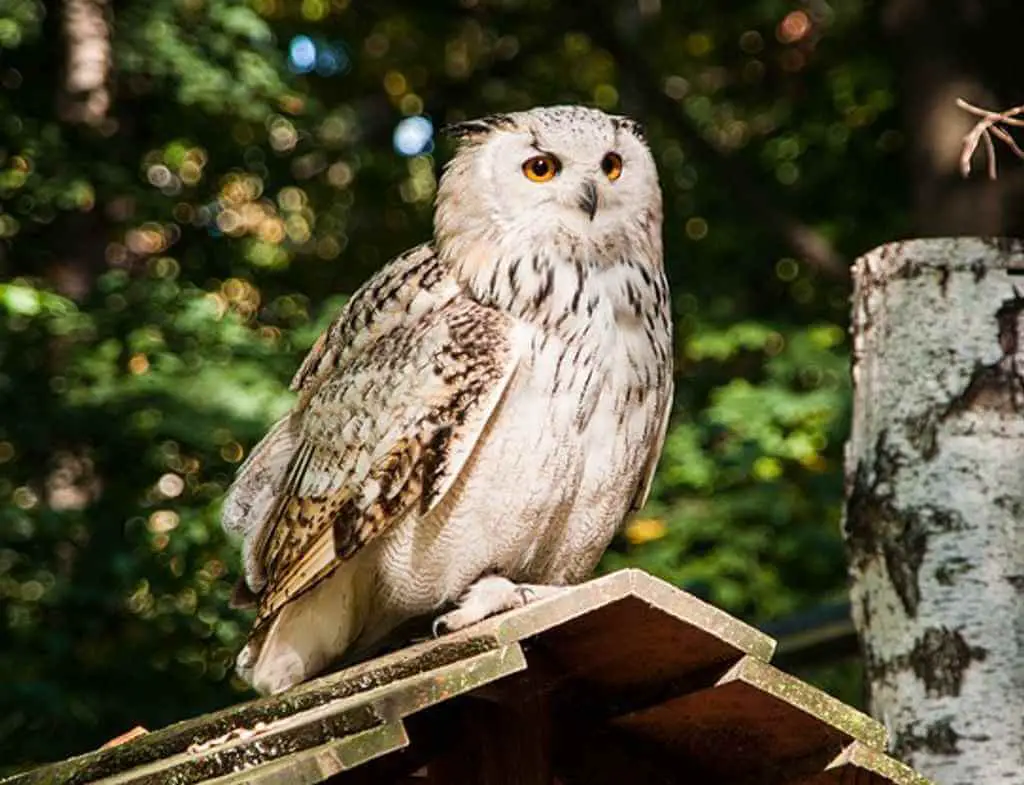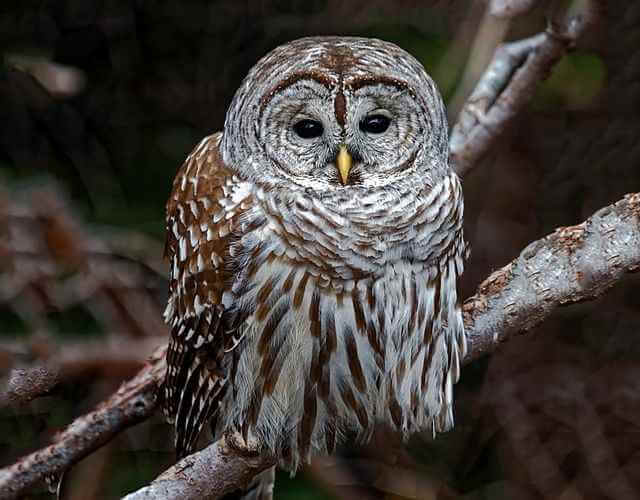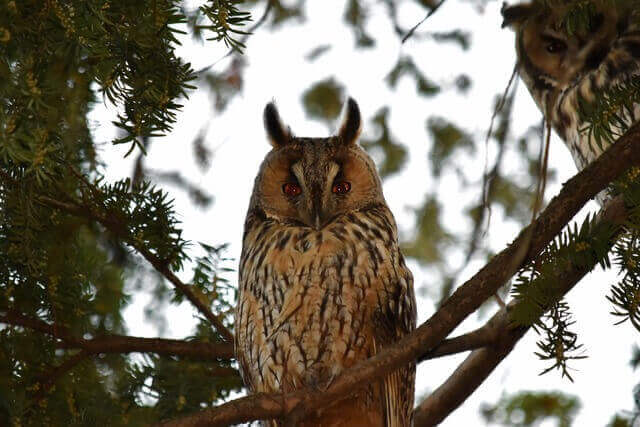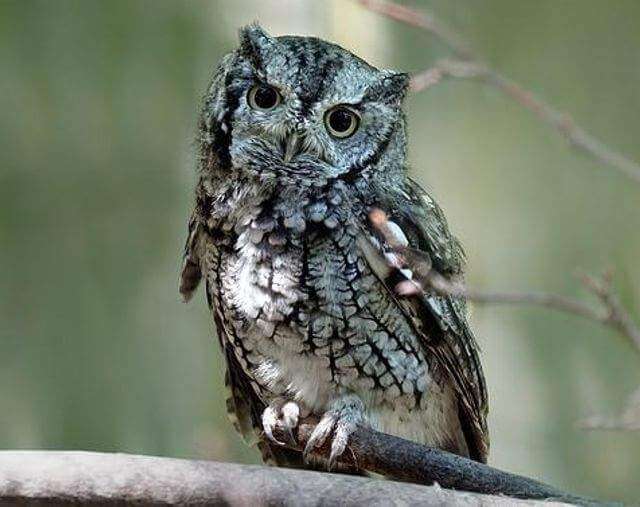The owl is a common sight in many parts of the world, but it can be hard to spot in Maryland. In this article, we will explore the 9 species of owls in Maryland in 2023 with photos, stats, information and frequency of occurrence.
Table of Contents
Species of Owls in Maryland
Barred Owl
- Length: 16.9-19.7″ in (43-50 cm)
- Weight: 16.6-37.0 oz. (470-1050 g)
- Wingspan: 39.0-43.3″ in (99-110 cm)
- Scientific Name: Strix varia
- Frequency of Occurrence: 2.29% (Statistic by: eBird)
- Where To Find Them: These owls prefer open habitats with plenty of trees and bushes for nesting. The best places to find them are in the Baltimore-Washington Metropolitan Area and around Frederick, MD.
- What Attracts Them: These owls are attracted to open spaces and areas with dense tree coverage. They are also attracted to rodents, birds, and small animals.
General Information: The barred owl is a large and impressive bird of prey that can be found throughout much of North America. The barred owl has a wide geographic range, which includes most of the United States as well as parts of Canada and Mexico.
The barred owl mainly eats small mammals, such as rabbits and squirrels, but will also eat birds if they are available. They are able to catch their prey by flying silently and then pouncing on their prey. The barred owl nests in tree cavities or on high ground, usually laying two eggs.
Great Horned Owl
- Length: 17.7-24.8 in (45-63 cm)
- Weight: 32.1-88.2 oz. (910-2500 g)
- Wingspan: 39.8-57.1 in (101-145 cm)
- Scientific Name: Bubo virginianus
- Frequency of Occurrence: 0.9269%
- Where To Find Them: Great Horned Owls are found throughout the state of Maryland, and they can be found in many different locations. Some of the best places to find these owls are in the forests near Baltimore, and in the mountains near Frederick.
- What Attracts Them: There are many things that attract great horned owls to North America, but some of the main reasons are the availability of food and the large number of potential nesting sites. These owls are masters of hunting in night environments, so having plenty of prey available is essential for their survival.
General Information: The great horned owl is a large, powerful bird of prey that ranges throughout North America. The great horned owl is the largest owl in the United States and one of the largest in the world. Great horned owls can weigh as much as 5.5 pounds and have a wingspan of up to 5 feet.
Great horned owls are found across most of North America, from Alaska to Tierra del Fuego, with a few populations in southern Canada. They inhabit open woods, meadows, and farmland, but are also common in urban areas. Great horned owls feed mainly on small mammals, though they will also eat birds and other animals. They build their nests in tall trees or on high cliffs.
Related Post: 35 Fun Facts About The Great Horned Owl (Detailed)
Eastern Screech Owl
- Length: 6.3-9.8″ in (16-25 cm)
- Weight: 4.3-8.6 oz. (121-244 g)
- Wingspan: 18.9-24.0″ in (48-61 cm)
- Scientific Name: Megascops asio
- Frequency of Occurrence: 0.8136%
- Where To Find Them: Eastern Screech Owl locations in Maryland can be found in the counties of Allegany, Baltimore, Carroll, Cecil, Frederick, Harford, Howard, Kent, Montgomery, Prince George’s and Washington. These owls are typically found residing in open woodlands with lots of trees and shrubs.
- How to Attract: Find a location with plenty of tall trees and open spaces. An eastern screech owl’s natural habitat is the forests of the northeast United States and Canada, so finding a spot that resembles this will help attract the bird. Make a nest out of sticks, twigs, or other available materials. Eastern screech owls build their nests in high places to keep watch over their territory and young. Feed the bird frequently. This creature consumes large amounts of small prey such as insects and rodents, so offering it food regularly will encourage it to stay near your home.
General Information: Eastern Screech Owl is a medium-sized owl found in the eastern half of North America. They reside in open woods, fields, and suburbs. Their diet consists mainly of small rodents, but they also eat birds, eggs, and carrion. Eastern Screech Owls are solitary animals that breed during the winter months.
They build a large stick nest near a tree or on top of a high point. The female lays 3-5 eggs and incubates them for about 30 days. The young owls fledge about 12 weeks after hatching and remain with their parents for another few months before finding their own territory.
Short-eared Owl
- Length: 13.4-16.9 in (34-43 cm)
- Weight: 7.3-16.8 oz. (206-475 g)
- Wingspan: 33.5-40.5 in (85-103 cm)
- Scientific Name: Asio flammeus
- Frequency of Occurrence: 0.1465%
- Where To Find Them: These owls can be found in all of the state’s counties, but they are most common in Montgomery and Frederick counties.
- How to Attract: The best way to attract a short-eared owl is to provide them with plenty of prey options.
General Information: The Short-eared Owl is a small owl found in the northern portions of North America. The range of this owl extends from Alaska to Newfoundland, and south to the Carolinas and Georgia. They inhabit forests, woodlands, and prairies. The Short-eared Owl is principally a nocturnal owl, but will also forage during the day.
Their diet consists mainly of rodents and other small animals, but they will also eat birds and eggs. They typically build their nests in trees or on high ground, but have been known to nest on rooftops. The lifespan of the Short-eared Owl is around 12 years.
Snowy Owl

- Length: 20.5-27.9 in (52-71 cm)
- Weight: 56.4-104.1 oz. (1600-2950 g)
- Wingspan: 49.6-57.1 in (126-145 cm)
- Scientific Name: Bubo scandiacus
- Frequency of Occurrence: 0.0967%
- Where To Find Them: This large owl can be found throughout the state, but some of its best locations include Cumberland National Forest and The National Wildlife Refuge at Huntingtown.
- How to Attract: If you are wanting to attract a snowy owl, there are a few things that you need to keep in mind. First and foremost, these animals require a lot of space. They will typically live in an area that is at least 20 acres big, and ideally much larger. Secondly, these owls are very territorial and require your full attention if you want them to stay nearby. Finally, make sure that you provide them with plenty of food and shelter.
General Information: The Snowy Owl is a large owl that is found in the Rocky Mountains and across much of North America. It has a wide range and can be found from Alaska to California, with the majority of its range in Canada. The Snowy Owl is typically associated with cold climates, as it primarily hunts for small prey in open country.
The Snowy Owl eats mostly small rodents and birds, but will also eat carrion if available. It nests in high altitudes, typically constructing a platform of sticks and feathers in a tree or on top of a cliff.
Related Post: 48 Fun Facts About Snowy Owls (with Photos, ID & Info)
Northern Saw-whet Owl
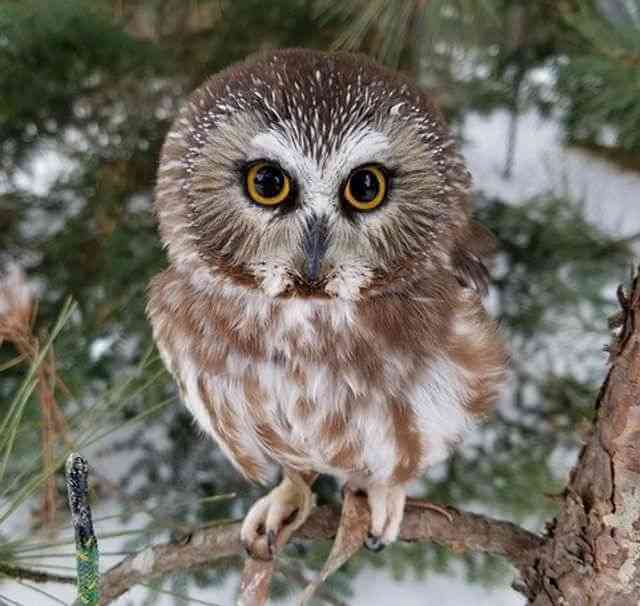
- Length: 7.1-8.3 in (18-21 cm)
- Weight: 2.3-5.3 oz. (65-151 g)
- Wingspan: 16.5-18.9 in (42-48 cm)
- Scientific Name: Aegolius acadicus
- Frequency of Occurrence: 0.0518%
- Where To Find Them: In Maryland, they can be found in areas including Garrett State Forest, Assateague Island National Seashore, and Mount Airy Forest.
- How to Attract: The Northern Saw-whet Owl is not commonly seen. In order to attract this owl to your garden or property, you will need to provide plenty of food and nest boxes. You can also create artificial nest sites by hanging a nest box from a tree or building platforms in your yard.
General Information: The Northern Saw-whet Owl is a small owl found in the boreal forests of North America. It has a wide range in Canada, the United States and Mexico. The owl is mainly active during the night, hunting small prey such as rodents, birds and other small animals. The owl feeds primarily on insects, but also consumes some larger prey such as voles and snakes.
Northern Saw-whet Owls typically nest in tree cavities or under cover near water. They lay 2-4 eggs which are incubated by the female for about 29 days. After hatching, the owlets fledge around 10 weeks old and will leave the nest to hunt for food on their own.
Related Post: What is the Smallest Owl in North America?
Barn Owl
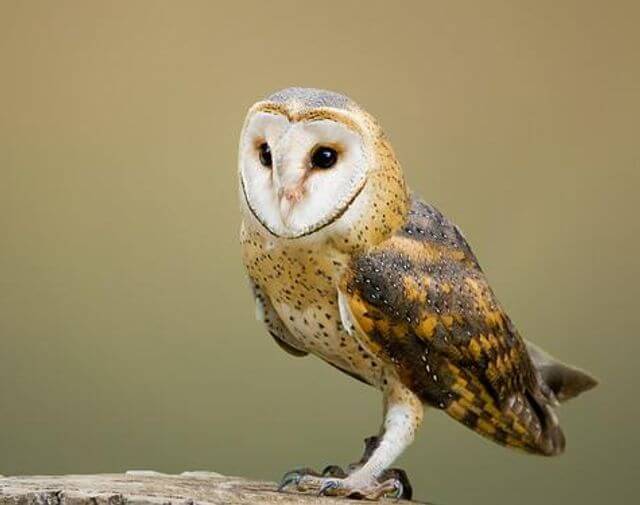
- Length: 12.6-15.8″ in (32-40 cm)
- Weight: 14.1-24.7 oz. (400-700 g)
- Wingspan: 39.4-49.2″ in (100-125 cm)
- Scientific Name: Tyto alba
- Frequency of Occurrence: 0.0475%
- Where To Find Them: Barn owls are found in Maryland in the following locations: Baltimore, Frederick, Hagerstown, and Westminster.
- How to Attract: They are often found in open areas near barns and other large structures. Barn owls hunt mainly at night but will also scavenge during the day. To attract barn owls to your property, create an owl-friendly environment by including open spaces, tall trees, and plenty of rodent prey.
General Information: Barn owls are widespread in North America, and are common in rural areas and open woodlands. They range from the Arctic to central Mexico. Barn owls typically inhabit forests, but they can also be found near farms and other areas with lots of trees.
Barn owls eat small mammals, birds, and insects. They usually hunt by watching from a perch or by flying out to catch their prey. Barn owl nests are typically in tall tree cavities, but they have been known to nest on buildings and other man-made structures.
Long Eared Owl

- Length: 13.8-15.8 in (35-40 cm)
- Weight: 7.8-15.3 oz. (220-435 g)
- Wingspan: 35.4-39.4 in (90-100 cm)
- Scientific Name: Asio otus
- Frequency of Occurrence: 0.0265%
- Where To Find Them: Maryland has several locations where you can find this owl, including Salisbury National Wildlife Refuge, Assateague Island National Seashore and Calvert Cliffs State Park.
- How to Attract: There are a number of ways to attract Long Eared Owls to your property, but some tips include providing plenty of food and nesting materials, installing an owl perch or platform.
General Information: The Long Eared Owl is a medium-sized owl found throughout the United States and Canada. It is a migratory bird that spends the winter in Central and South America. The Long Eared Owl has a range of around 13 million acres, with most of its population living in the central and eastern portions of its range.
The owl is primarily herbivorous, feeding on insects, small rodents, and other small animals. However, it will also consume large amounts of fruit when available. Nests are built in trees or on high ground, typically close to water sources.
Burrowing Owl
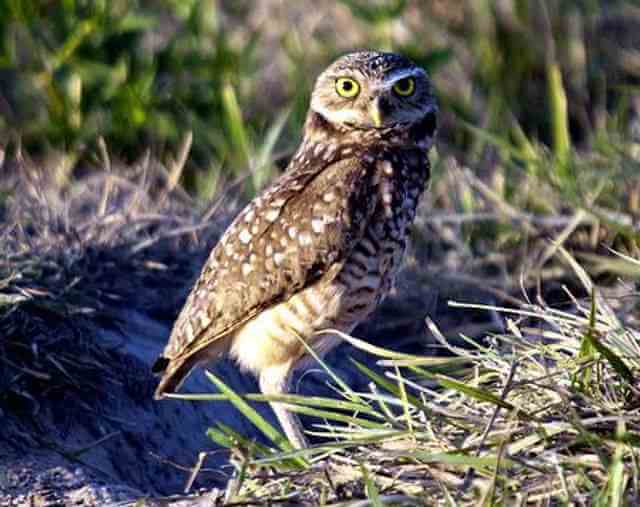
- Length: 7.5-9.8″ in (19-25 cm)
- Weight: 5.3 oz. (150 g)
- Wingspan: 21.6″ in (55 cm)
- Scientific Name: Athene cunicularia
- Frequency of Occurrence: 0.0005%
- Where To Find Them: Burrowing Owl can be found nesting in many locations throughout Maryland. Some popular spots include Assateague National Park and the Chesapeake Bay Area.
- How to Attract: Burrowing Owls are generally shy animals and will generally avoid humans unless they are provoked. One way to attract a Burrowing Owl is to provide them with a environment that is conducive to their needs. This means providing them with areas for nesting, hunting and gathering food.
General Information: The Burrowing Owl is a small, nocturnal owl that hails from the eastern United States and Canada. It is the only species of owl that digs its own nest in the ground. The Burrowing Owl’s range extends from southeastern New England south to Florida and west to Texas.
The owl prefers open woods with plenty of trees and understory, but can also be found in urban areas. Its diet consists mostly of small mammals, such as rabbits, voles, and squirrels, but it will also eat birds and insects. The Burrowing Owl mates in April and May and lays 2-3 eggs in a burrow dug into sandy soil. Want to learn more about the burrowing owl, then check out this article: Really Cool Burrowing Owl Facts That Will Amaze You!
Related Post: Most Common Backyard Birds In Maryland (Explained)

